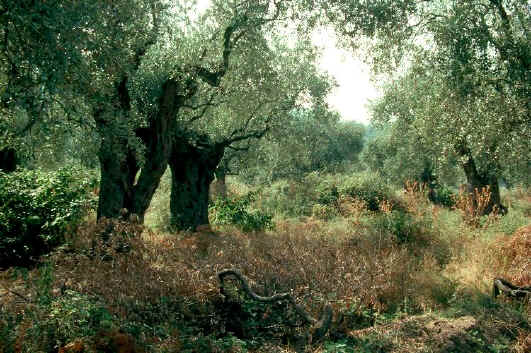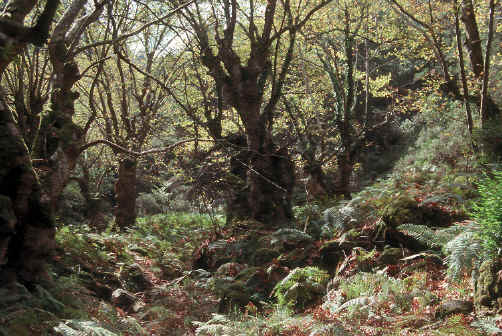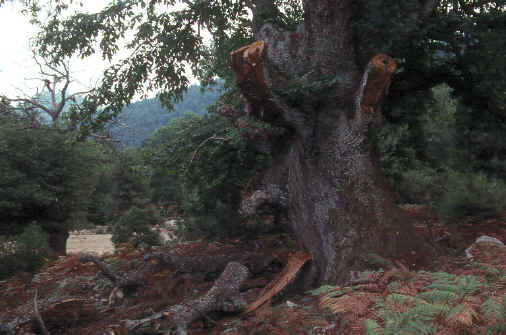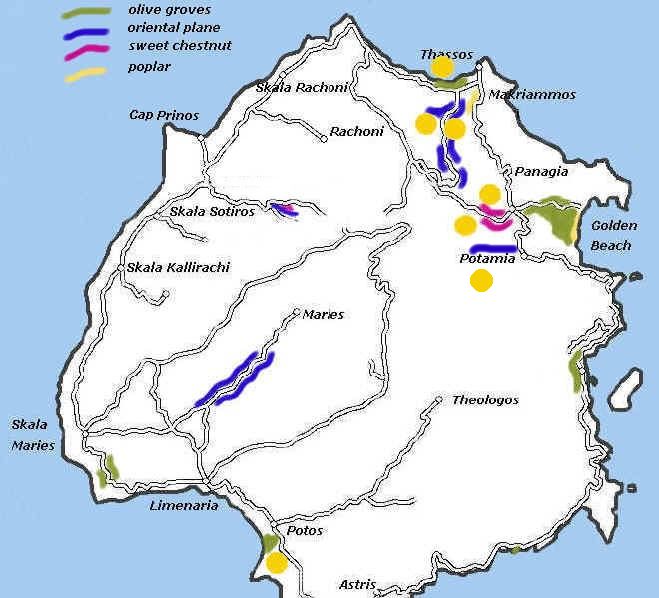______________________________________________________________________
BROAD-LEAVED
WOODLAND
 Conifer
forests dominate much of the landscape of Thásos but olive groves Olea
europaea are the most
abundant broadleaf woodland habitat, covering 7,400 hectares (21%) of the island. Although obviously planted and an important
part of the local agriculture, these pasture woodlands support a rich variety
of wildlife. Many groves are clearly very ancient and consist of hollow trees
that provide niches for dead wood invertebrates, birds, reptiles and
(presumably) bats.
Conifer
forests dominate much of the landscape of Thásos but olive groves Olea
europaea are the most
abundant broadleaf woodland habitat, covering 7,400 hectares (21%) of the island. Although obviously planted and an important
part of the local agriculture, these pasture woodlands support a rich variety
of wildlife. Many groves are clearly very ancient and consist of hollow trees
that provide niches for dead wood invertebrates, birds, reptiles and
(presumably) bats.
They vary much in
their significance as a result of past and current land use and this is
reflected in their ground layer. Neglected groves, which are declining in
abundance, have an understorey of tall shrubs, known as shibylak (see Scrub).
They contain a diverse range of scrub species, supporting a rich invertebrate
fauna, and probably constitute the most significant habitat on the island for
breeding birds. Most groves are grazed to a greater or lesser extent by goats or
sheep and beneath the olive canopy the ground layer is often composed of
flower-rich grassland (though parched by early summer), representing some of the
best examples of lowland grassland habitat on the island. Olive groves are
widely distributed around the coast and all are worthy of exploration.
Particular concentrations of important olive groves can be found on the western
outskirts of Thassos Town, on the floodplain of the Skala Potamia basin, around
Kinira, on the Aliki isthmus, east of Potos, and along the coast between Skala
Maries and Limenaria.
Other broadleaved
woodland habitat types are very localised on Thásos. Behind the beach at Skala
Potamia is a fringe of sallow Salix spp. and mature poplar Populus
alba but this is limited in extent
and threatened by tourist development. Dense poplar woodland, much of it quite
young, occurs to the south-east of Thassos Town but wet woods are naturally
scarce on the island and should be conserved wherever possible. Deciduous tree
species such as oriental hornbeam Carpinus orientalis and various oaks Quercus spp. occur
widely as scattered components of maquis but the only other
 significant
broadleaf woodland
species are oriental plane Platanus orientalis and sweet chestnut Castanea
sativa. Magnificent ancient planes occur
as planted specimens in many of the towns and villages but natural plane
woodland is confined to the banks of streams and rivers. In the floodplain of
the Maries river there is a narrow band of plane woodland stretching for
several kilometres but the best example I have seen on the island is in the
valley of the main river above Thassos Town. Here there are concentrations of
venerable plane trees extending up to the marble quarries and one tributary in
particular supports more than fifty superb trees in a woodland setting that is
more reminiscent of central and northern Europe than the Aegean. These trees are
clad with tree lungwort Lobaria pulmonaria
and most are hollow, suggesting that this is an ancient remnant woodland and
probably of great importance for the conservation of 'old woodland' organisms on
Thásos. This is probably one of the island's oldest examples of the
phytosociological community known as Plantanion orientalis, which is
reported to occur as a distinctive representative on Thásos and is typical of
shaded stream banks. Other good examples of this habitat are along the banks of
the main gorge at Mikros Kazaviti and in the valley
above Potamia that is the route of the mountain track up to Ipsarion, where
numerous old planes occur.
significant
broadleaf woodland
species are oriental plane Platanus orientalis and sweet chestnut Castanea
sativa. Magnificent ancient planes occur
as planted specimens in many of the towns and villages but natural plane
woodland is confined to the banks of streams and rivers. In the floodplain of
the Maries river there is a narrow band of plane woodland stretching for
several kilometres but the best example I have seen on the island is in the
valley of the main river above Thassos Town. Here there are concentrations of
venerable plane trees extending up to the marble quarries and one tributary in
particular supports more than fifty superb trees in a woodland setting that is
more reminiscent of central and northern Europe than the Aegean. These trees are
clad with tree lungwort Lobaria pulmonaria
and most are hollow, suggesting that this is an ancient remnant woodland and
probably of great importance for the conservation of 'old woodland' organisms on
Thásos. This is probably one of the island's oldest examples of the
phytosociological community known as Plantanion orientalis, which is
reported to occur as a distinctive representative on Thásos and is typical of
shaded stream banks. Other good examples of this habitat are along the banks of
the main gorge at Mikros Kazaviti and in the valley
above Potamia that is the route of the mountain track up to Ipsarion, where
numerous old planes occur.
Sweet chestnuts
are also planted for their produce, chiefly around the mountain village of
Panagia. Just above the village, growing amongst mixed conifer scrub and Kermes
oak maquis, there are a hundred or so ancient sweet chestnut trees that must be
at least 300 years old. Most of the trees grow adjacent to the forest track and
were presumably planted several centuries ago for the autumn harvest of nuts,
but they may
 represent
a relict of native chestnut woodland. The health of the trees varies but most
have abundant dead wood in the canopy and a high proportion are damaged by the
extensive larval workings of saproxylic beetles, which riddle the heartwood of
trunks and major limbs. The main species concerned is the impressive longhorn Cerambyx
welensii, whilst
scarabaeid larvae, possibly Gnorimus variabilis, are also frequently seen
under bark on the trunks of the biggest trees. This relatively small area of woodland is exceptional on Thásos and
should be regarded as a high priority for conservation and management. Planting
of new generations of chestnuts are required and efforts to stop the removal of
fallen timber for firewood would be welcome. There are reports of typical
Mediterranean chestnut woods, with Cornelian cherry understorey around the villages of Mikro and Megalo Kazaviti
which obviously need investigation. Above Mikros Kazaviti is an extremely
interesting area of neglected terraces which supports pedunculate oak Quercus
robur and sweet chestnut wood pasture. The oaks are relatively young but the
chestnuts, whilst not as old as those at Panagia, are probably 2-300 years old.
represent
a relict of native chestnut woodland. The health of the trees varies but most
have abundant dead wood in the canopy and a high proportion are damaged by the
extensive larval workings of saproxylic beetles, which riddle the heartwood of
trunks and major limbs. The main species concerned is the impressive longhorn Cerambyx
welensii, whilst
scarabaeid larvae, possibly Gnorimus variabilis, are also frequently seen
under bark on the trunks of the biggest trees. This relatively small area of woodland is exceptional on Thásos and
should be regarded as a high priority for conservation and management. Planting
of new generations of chestnuts are required and efforts to stop the removal of
fallen timber for firewood would be welcome. There are reports of typical
Mediterranean chestnut woods, with Cornelian cherry understorey around the villages of Mikro and Megalo Kazaviti
which obviously need investigation. Above Mikros Kazaviti is an extremely
interesting area of neglected terraces which supports pedunculate oak Quercus
robur and sweet chestnut wood pasture. The oaks are relatively young but the
chestnuts, whilst not as old as those at Panagia, are probably 2-300 years old.
The map displays
locations of the more significant broadleaved woodlands on the island.







 significant
broadleaf woodland
species are oriental plane Platanus orientalis and sweet chestnut Castanea
sativa. Magnificent ancient planes occur
as planted specimens in many of the towns and villages but natural plane
woodland is confined to the banks of streams and rivers. In the floodplain of
the Maries river there is a narrow band of plane woodland stretching for
several kilometres but the best example I have seen on the island is in the
valley of the main river above Thassos Town. Here there are concentrations of
venerable plane trees extending up to the marble quarries and one tributary in
particular supports more than fifty superb trees in a woodland setting that is
more reminiscent of central and northern Europe than the Aegean. These trees are
clad with tree lungwort
significant
broadleaf woodland
species are oriental plane Platanus orientalis and sweet chestnut Castanea
sativa. Magnificent ancient planes occur
as planted specimens in many of the towns and villages but natural plane
woodland is confined to the banks of streams and rivers. In the floodplain of
the Maries river there is a narrow band of plane woodland stretching for
several kilometres but the best example I have seen on the island is in the
valley of the main river above Thassos Town. Here there are concentrations of
venerable plane trees extending up to the marble quarries and one tributary in
particular supports more than fifty superb trees in a woodland setting that is
more reminiscent of central and northern Europe than the Aegean. These trees are
clad with tree lungwort  represent
a relict of native chestnut woodland. The health of the trees varies but most
have abundant dead wood in the canopy and a high proportion are damaged by the
extensive
represent
a relict of native chestnut woodland. The health of the trees varies but most
have abundant dead wood in the canopy and a high proportion are damaged by the
extensive 